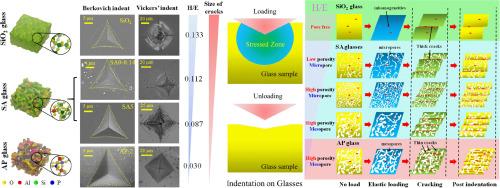Deformation mechanisms of nanoporous oxide glasses: Indentations and finite element simulation
IF 8.3
1区 材料科学
Q1 MATERIALS SCIENCE, MULTIDISCIPLINARY
引用次数: 0
Abstract
Nanoporous oxide glasses have a wide array of applications including medicine, sensor and optics, owing to their high thermal and chemical stability. However, the correlations between their topological structure, glass system and mechanical properties are still poorly understood. In this paper, we bridged this structure-composition-property gap by utilizing nanoindentation and finite element simulation on two series of sol-gel derived nanoporous glasses: phosphate (AP) and silicate (SA) glasses. The critical length of cracks 2ac was found much smaller in the AP glasses (7.3 nm) than in the SA glasses (20.3 nm). As a result, the AP glasses with larger pores (6∼10 nm) were more easily crushed than the SA glasses with finer pores (1∼6 nm). Similar small physical activation volumes Ω (2∼3 nm3) have been measured in fully dense SiO2 glass and the porous glasses with lower porosity (< 30 %) or smaller pore size (< 2 nm), indicating the catastrophic cracks initiate at the inhomogeneities of glass network, regardless of its porous structure or not. The linear dependence of Ω on pore size or porosity probably arise from the less constrained porous structure, and the shearing crack prefer to nucleate on the pore wall under compression. The deformation mechanisms of nanoporous glasses have been summarized and rationalize the evolution of brittle fracture behaviors in the SA and AP glasses. The hardness H and elastic modulus E of porous glasses were found still obey the classical Gibson & Ashby's model, which is valuable to develop novel porous glasses for future industrial applications.


求助全文
约1分钟内获得全文
求助全文
来源期刊

Acta Materialia
工程技术-材料科学:综合
CiteScore
16.10
自引率
8.50%
发文量
801
审稿时长
53 days
期刊介绍:
Acta Materialia serves as a platform for publishing full-length, original papers and commissioned overviews that contribute to a profound understanding of the correlation between the processing, structure, and properties of inorganic materials. The journal seeks papers with high impact potential or those that significantly propel the field forward. The scope includes the atomic and molecular arrangements, chemical and electronic structures, and microstructure of materials, focusing on their mechanical or functional behavior across all length scales, including nanostructures.
 求助内容:
求助内容: 应助结果提醒方式:
应助结果提醒方式:


